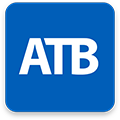Download ATB’s Cash Flow Forecast Template
For established entrepreneurs, cash ebbs and flows can often be difficult to manage because there are so many moving parts. But creating a financial forecast can be a powerful tool to help your business adapt to unexpected circumstances.
The cash flow cycle involves inflows, outflows and cash on hand. A cash flow forecast is your monthly or quarterly prediction of that cycle to help you understand the relationships between accounts receivable, accounts payable, payment terms, credit policy and inventory. It allows you to identify gaps before they happen and generate the necessary working capital.
How to forecast
Projections are about predicting when the cash will actually arrive—not when the invoice is sent or the job is done. The same goes for things like bill payments: record it as an expense when you expect the money to leave your account. It’s important to track when because you need to know how much cash will be available at any given time so you can meet obligations and be adaptable if unexpected expenses arise.
💡 CASH FLOW TIPBase projections on the date you expect:
|
Steps:
- Use ATB’s Cash Flow Forecast Template. Select the bottom tab called “Cash flow 1-24 months.” The first section is to project revenue. Starting in line 5, list product names, units and average cost. This is also the spot to add other funding. If you take out a loan or inject money from your personal account into the business, those funds should appear as a cash inflow on line 18 or 19.
- Project Cost of Goods Sold (COGS). Starting at line 25, input what percentage of the sales cost goes towards COGS.
- Project general/operating expenses starting in line 31. (You can change this section's categories to suit your business’ needs.)
- Review the bottom line to see shortfalls or surpluses so you can plan accordingly. Cumulative cash flow will tell you what should be in your bank account at the end of the month.
When there’s a surplus, you can reinvest money back into your business, invest in stocks or bonds, make additional loan payments, build up your emergency fund or distribute dividends.
When there’s a shortfall, you can cut costs (by renegotiating contracts, finding energy-saving measures or exploring cheaper marketing strategies), increase revenue (by offering promotions, creating a new product or expanding into new markets), offer incentives for early payments, explore short-term lending options or find other ways to bridge the gap. - Review your forecast: Quarterly works for most businesses. Monthly works if you are in a growth period.
Common challenges
Here are common roadblocks entrepreneurs experience when using cash flow templates:
- Inaccurate assumptions: If your assumptions about revenue, expenses and timing are wrong—too optimistic or conservative—your forecast could be inaccurate. Overcome that by identifying all fixed costs and validating assumptions with market research, data and industry benchmarks.
- Inadequate monitoring: Poorly managing working capital can disrupt operations, and failing to monitor cash flow regularly can result in missed opportunities or financial difficulties. Overcome this by setting aside time each month to review cash flow statements, note discrepancies and take corrective actions.
- Overlooking seasonal variations: Seasonal fluctuations can pose challenges when you use static cash flow templates. Overcome this by incorporating seasonal variations into your projections by adjusting revenue and expense forecasts accordingly, using historical data to identify patterns and creating separate forecasts for different seasons.
- Ignoring debt obligations: Debt repayments can significantly impact cash flow if not adequately accounted for in projections. Overcome that by including debt service obligations in cash flow projections or prioritizing timely payments to avoid penalties.
- Not planning for growth: Entrepreneurs often focus solely on short-term cash flow needs and overlook long-term initiatives, like investments in marketing, training, research or expansion. Overcome that by balancing short-term requirements with long-term goals and allocating resources to support growth while ensuring enough liquidity.
Realistic expectations
Accurate projections act as your financial compass, empowering you to make better decisions, stick to your budget, pinpoint potential challenges and adapt in difficult circumstances. Understanding your projections also allows you to have informed discussions with your advisory team, including your banker, bookkeeper and accountant. Gather data on your past performance and market trends, and use that information to make realistic projections about future revenue, expenses and market conditions.
Instead of relying on a single forecast, consider creating multiple scenarios based on different assumptions—like best case, worst case, cost reduction or market expansion—to enhance your flexibility in the face of uncertainty.
Recap: Anticipate money movement
It’s important to use data to inform your cash flow projections, factor in all your monthly expenses and review your forecast regularly. Creating a cash flow forecast is about anticipating when cash is moving. Realistic cash flow projections boost your ability to make smart decisions, budget, identify issues, demonstrate financial stability and be flexible. If you’re unsure of how to proceed with the template, chat with an ATB business advisor for guidance.
